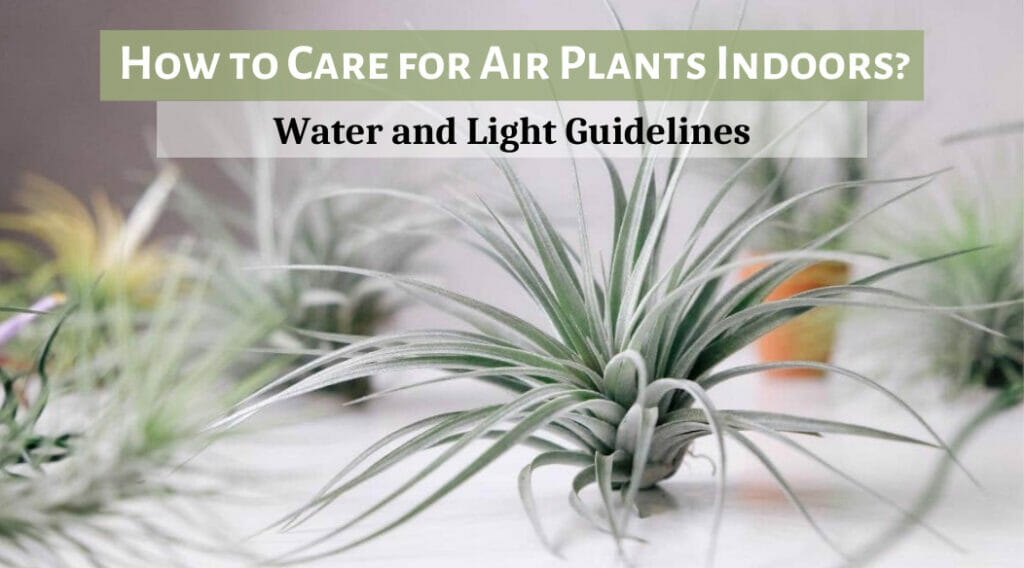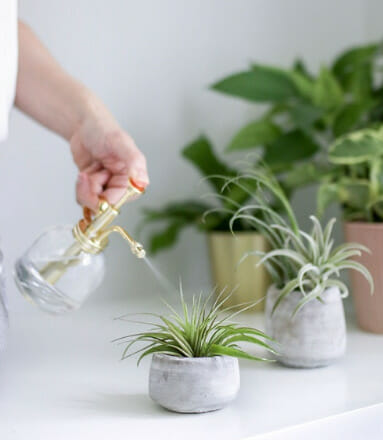If you are looking for easy-care and beautiful plants for your house, air plants are the best option. Air Plants: Tillandsias are plants that directly draw their nutrients from the air. However, you may wonder if air plant doesn’t need soil, then how to care for air plants indoors? This article will provide answers to all the questions you have in mind about the care of air plants.

1. What are Air Plants?
They are an epiphyte, which means they grow on the surface of other plants and get their nutrients from the air. The most significant advantage of air plants is that they do not need soil for nourishment. That is why they are mostly grown indoors, as they add to the house’s beauty and are very easy to move.
So, you will not have to worry about the mess of soil and pot mixings. But, they require air, light, and water for better and proper growth. If you are growing an air plant for the first time and want to know about them, this article is for you.

Related Article: How Do Air Plants Grow Without Soil? – A Beginner’s Guide
2. How to Care for Air Plants Indoors?
Although the air plants do not require soil, they still need your attention to grow properly. Don’t worry if it is your first time growing an air plant because we are here with all the tips you should know for your lovely air plants.
Like any other plants, light and water are the most necessary things that air plants require to bloom. So, let’s dive into the lighting and watering conditions for the air plants.
2.1. Lighting Conditions
Light is the most important thing for any plant to survive. As air plants are the natives of the forests of America and northern Mexico, they have a tropical nature. In other words, air plants require bright but indirect light to flourish. Also, air plants need almost 12 hours of sunlight in one day.
So, where to place the air plant? The best spot for your adorable air plant is a room having an east-facing or a south-facing window. As these windows make the room stay bright for most of the day, it is the best place for your air plant.
If your air plant is placed in front of a west-facing window, it is time to change that spot. West-facing windows do not receive much light, and when they do, it has a very high intensity which isn’t healthy for the plant. Moreover, do not forget to mist your air plants as higher humidity allows them to bear bright light.

2.1.1. Can You Grow an Air Plant With Artificial Light?
Of course, you can grow your air plant via artificial light. Artificial light comes in handy if your home doesn’t have an east-facing window or you’re growing plants in the basement. But make sure that you are using a full-spectrum light. Furthermore, keep your air plant almost 3 ft away from the light and use an automatic timer to ensure the better health of the plant.
2.2. Watering Conditions
The watering conditions for the air plants vary concerning their size, the light they are receiving, and their spot. Following are some tips to ensure that your air plant is getting enough water:
- The best way to water the air plants is to immerse them in water once a week. Make sure you do not soak them in water for more than 5-10 minutes.
- After sinking them into the water, shake the plant to get rid of extra water. Removing excess water is crucial as it puts the air plants at risk of crumbling.
- The best time to water the plants is during the day because air plants take at least 3-4 hours to dry. Make sure that the plant has dried; otherwise, it may rot.
- You can also use a sprayer to mist the air plants once or twice a week as it creates better humidity conditions for the plant.
- Water requirements also vary with the season. For instance, in summer, you will need to water the air plants more often. On the other hand, in winter, air plants require lesser water.
- Lastly, make sure to place them in brighter and more indirect light after watering them.
- Also, try to use bottled or rainwater for air plants. It’s because soft water and tap water have salts and minerals that may prevent the plant from nutrient extraction.


2.2.1. How to Know If My Air Plant Is Getting Enough Water?
If the shiny leaves of your air plant turn brown, this indicates that it is being underwatered. Moreover, if the shapes of the leave change or they seem droopy, then it is also a sign of them not getting enough water.
Over-watering the air plants can also lead to rot. If the lower portion of the air plant turns blackish-brown and the leaves begin to fall out, it indicates that it was over-watered and is now decaying. Therefore, make sure you water your air plants moderately.
Related Article: Air Plant Watering: The Soaking Method
2.3. Fertilizer:
As mentioned earlier, air plants gather their nutrients from the air, so there is no need to use a fertilizer. It is also a benefit as it helps you save money. But, if you want to optimize the growth of air plants, you can use a diluted liquid fertilizer.
2.4. Temperature:
Because air plants are tropical, warmer temperatures are ideal for their growth and blooming. To be more precise, temperature ranging from 50-90 Fahrenheit is most suitable for them. if the temperature drops below 40°C, then the plant may die.
3. Problems With Air Plants
Like any other plant, air plants can also face water and humidity problems. But do not worry! The following tips will help you recognize them and to save your plants from them:
- Brown Leafs
If the leaves of your air plant start turning brown and crispy like toast, then it is a sign that they are not getting enough moisture.
To solve this problem, try increasing the watering time of the plant. Also, mist them more often and place them in a more humid area.
- Sloppy Stems
If you observe the stems of your air plants getting soft and sloppy, they are getting more than the required amount of water. Over-watering can only be cured if it is just the start; otherwise, your plant will decay. In this case, try skipping a watering day to make sure it gets dry.


Final Thoughts
So far, this article has guided you on how to care for air plants indoors. All you have to do is to keep track of the watering and lighting conditions. As long as you follow the guidelines, growing air plants is all about having peace of mind and satisfaction.
Follow our website for more articles on indoor plants and plants care.
